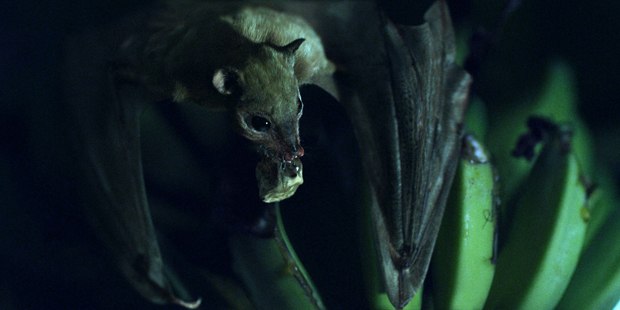Method's Tom Smith tells us all about the latest viral thriller from Steven Soderbergh.
Check out the Contagion trailers at AWNtv!
VFX supervisor Tom Smith has worked with director Steven Soderbergh on and off since The Limey. And when it comes to VFX, he says that Soderbergh understands its importance and pays attention to detail. Contagion, of course, is all about detail. It has to be: it's a frightening scientific procedural about understanding and containing a mysterious virus that's unleashed on the world like the Black Plague. It's gritty and shot with the Red digital camera; however, exotic shots of Hong Kong in flashback look opulent.
But overall it's a post-apocalyptic film about disturbing social and scientific reactions to a pandemic, the perfect metaphor for the 10th anniversary of 9/11. But when it came to VFX, there were targeted areas, including matte paintings of Chicago, enhancement of an incident in Hong Kong and, most crucially, some animation involving the MacGuffin.
"Production got a freeway to use for the evening, north of Chicago", explains Smith of Method Studios and the production supervisor. "There's a convoy of vaccines coming into Chicago, and so there's lots of military hardware and they were able to get a couple of National Guard helicopters. I shot some still photography off a rooftop south of the city the same time of day and in the same kind of light. We put that together as a matte painting and put it into the plate. The camera does a full 180 following the helicopters." He used Photoshop from still photos using Nuke.
Meanwhile, there's a scene on the streets of Hong Kong in which one of the victims gets struck by a truck. "We have a shot where he's walking and get the vehicle moving and hitting a solid dummy," Smith continues. "We did the transition of the guy walking to the vehicle hitting the guy and the aftermath overlooking the truck. It's a quick, jarring shot."
First, they shot the plate with the guy walking out onto the street; and the camera stayed in the same position and they shot the dummy. Then the truck came through There was no digital double. "We augmented the second shot with the vehicle approaching because of the dummy," he adds. "We modeled the arms in CG. It was a pretty rigid dummy with metal armature inside. We wanted to give it life. The truck runs into it and we did a quick split over from the dummy to the character during point of impact. Then we look at it from the other angle.
But the centerpiece is a CG-animated bat that figures prominently in the story. "Steven had this idea that the bat takes a piece of banana in close-up and moves on into the interior of a pig farm in Hong Kong, where it drops a piece of it and then pigs come on over and start eating it," Smith suggests.
The computer animation was done at Method's Vancouver office. They had previously done a bat for Tropic Thunder. But this one was close up and totally photoreal. They shot the plates early on in the schedule and were able to design and animate the bat right away.
"We fashioned it after a fruit bat from Southeast Asia," Smith continues. "I found a taxidermy bat that was similar. We had some live reference of a dehydrated bat to look at the transparency and translucency of the wings. The animators then looked around for good reference for how they moved."
But what Soderbergh was after was something very gnarly-looking that viewers would find disturbing. "He liked the concept and let us run with the bat and then when we got notes from him later. Its nose is real pointed and very [ugly] and just makes you [wince]."
In the first shot of the sequence, the bat lands on the bananas. From that point on, we push in tighter and see that he's eating one. He breaks a piece off and flies away. "We tried to get the head movements right. And they did a really nice job of getting quick gestures and movements. Flying was the other challenge to make sure the bat wings had a natural weight. They're pretty light. We went through a lot of iterations to get the flitter. They zig-zag and move erratically. There were initially five shots and then another one was added later. Part of the backstory was corporations involved in deforestation in the region. A bulldozer comes through and hits a palm tree and a group of bats flies away. Their environment gets disrupted and part of the unintended consequence is the spread of the virus.We used <Maya> and mental ray and composited in Nuke.
"The reaction we first got from him was that he liked how it made you feel uneasy. When it came to giving lighting notes, he'd say, 'I want you to put the light a little bit different on the bat so we have more side lighting. It really helps that he's the cinematographer."
Bill Desowitz is former senior editor of AWN and editor of VFXWorld. He has a new blog, Immersed in Movies (www.billdesowitz.com), and is currently writing a book about the evolution of James Bond from Connery to Craig, scheduled for publication next year, which is the 50th anniversary of the franchise.










